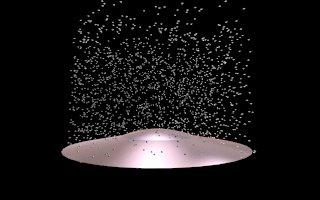
What is a Vacuum Thrust Aircraft [VTA]
?

What is a VTA ?
A VTA is an aircraft that is solely operated by the vacuum it generates in utilising the tremendous thrust from atmospheric pressure. Hence the term "Vacuum Thrust Aircraft". The tremendous thrust obtainable from atmospheric pressure allows a craft of any size and shape to overcome all the effects of gravity as we know it; with a far simpler, cleaner, cheaper more powerful method of flight than any other currently known means of propulsion.
How does a VTA utilise the Atmosphere as a source of propulsion ?

A vacuum aircraft would set up a vacuum over one half of the disc's surface. The above image shows cathode rays streaming off the upper aluminium surface of the VTA. This produces a deformation/disassociation of the air molecules. The deformed particles then race to rejoin the existing air particles in the surrounding air; in doing so, they leave an almost total vacuum in their wake. The resulting atmospheric pressure of air behind the craft then tries to race in to fill the void created by the absent air, an at the same time pushes the craft in the same direction. Depending on the current and voltage used, the amount of potential thrust available is unmatched by "any known man made force". The size and shape of the craft play no part in the operation of the device. Different design craft of various shapes and sizes are utilised into each separate field for their desired application. E.g.:
The Basic Operations of a V.T.A.
Vertical Flight

On lift off, the craft would utilise the entire top half of the disc shape to generate a vacuum in the upper region of air. This would give all vacuum aircraft the ability to make vertical take off and landings in very restricted spaces, eg. like mountain tops or the roofs of buildings. These types of aircraft make the need for runways virtually obsolete. A huge cost saving in both money and natural resources.
Forward + Altitude Flight

After the VTA has cleared the ground the hemisphere shaped control lever from inside the craft is move forward in the desired direction of flight. This moves the cathode ray generation on the outer layer of the craft in the desired direction, and thus, a vacuum is generated in the required direction. The atmospheric pressure will then push the craft into the vacuum void moving it up an forward. The overall speed in the direction of flight is proportional to the current an electrical charge applied to the cathode ray generation on the outer surface of the craft. If a high amount of power is supplied you will have an intense vacuum created; giving rise to an intense atmospheric push on the non ionised section of the craft.
Direct Horizontal Flight

Once the craft is at a safe altitude, and away from any ground based obstacles, the operator would place the control lever fully forward in the desired direction, and the electrical current would be increased to the cathode ray generation. The craft could then be free to obtain speeds of up to 40,000 km/hr; all supplied free from nature herself. The top speed of such a craft would allow it to reach anywhere in the globe in 30 minutes maximum. Think of the enormous benefits to trans- continental flight of passengers between countries or search and rescue? There is no sound or heat generated inside the vacuum field, therefore the associated problems of noise pollution and heat stress fractures are of no concern to a properly designed vacuum thrust aircraft. Noise pollution is virtually non-existent with respect to high speed flight or the built up areas around airports.
Descending Powered Flight

On coming into your destination the operator would move the control
lever forward to assist the craft to make a power descent; enabling safe
and rapid descent from high cruising altitudes.
The ability of moving the vacuum only around the surface of the craft
allows the craft itself to maintain a total horizontal position in flight.
This is beneficial in the larger carrying capacity craft, an further assisting
passenger comfort in transport type vehicles.
Author G.D.Mutch .
Copyright © 1997 . All rights reserved.
Revised: November
11, 1997.
